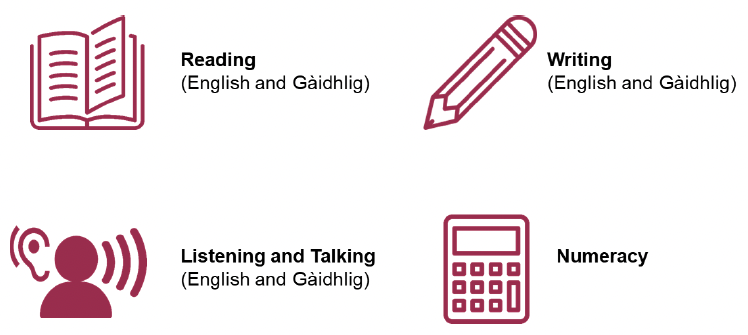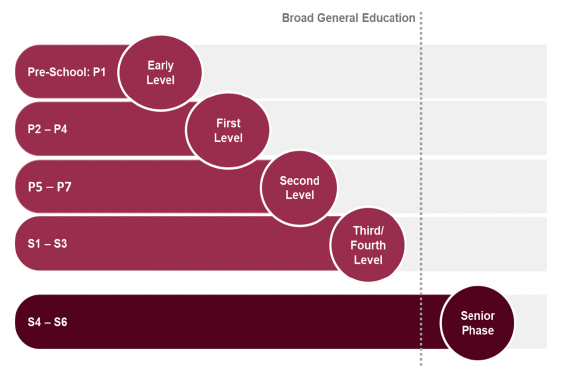Achievement of Curriculum for Excellence levels: 2021/22
Achievement of Curriculum for Excellence (CfE) Levels 2021/22 provides information on national performance in literacy and numeracy, based on all pupils in publicly funded Primary 1, Primary 4, Primary 7 and Secondary 3 classes, and for all pupils based in special schools/units.
Chapter 1: Introduction
1.1 Achievement of Curriculum for Excellence (CfE) Levels Data
This publication provides information on the proportion of school pupils who have achieved the expected Curriculum for Excellence (CfE) Levels in literacy and numeracy relevant to their stage.
Achievement of CfE level data are based on teachers' professional judgements of individual pupil performance (see Section 9.1.1 for more information). This report refers to the school year 2021/22; the data reflect what pupils have achieved by the end of the school year – i.e. June 2022.
Figures are based on pupils in publicly funded mainstream schools, in the 32 local authorities and one grant aided school. Pupils' ages are based on approximate age ranges.Data are collected for pupils in the stages that follow:

From these, a combined primary figure (P1, P4 and P7) has also been calculated.
The national and local authority data within this report cover pupils within mainstream schools, including those in special units integrated within mainstream schools. Pupils attending standalone special schools or standalone special units are excluded from the national and local authority data and are reported on separately in Chapter 6.
A small number of pupils (in both mainstream and special schools) for whom the teacher has been unable to make a professional judgement are not included.
Data are collected on pupil performance in four areas, known as organisers:

The achievement of 'literacy' is also included in the publication (for English and for Gàidhlig). A pupil is reported to have achieved the expected level in Literacy if they have achieved the expected level in all three of the literacy organisers: reading, writing, and listening and talking. For more information on how this has been calculated, see Section 9.1.3.2.
This publication mainly focuses on the organisers based in the English language and Numeracy. For pupils based in Gaelic medium schools/classes, the English language organisers are collected at relevant stages and are included in the national and local authority data. Information on achievement of CfE levels in Gàidhlig can be found in Chapter 5. For more information about Gaelic medium education, see Section 9.1.3.3.
1.2 Curriculum for Excellence Levels
Curriculum for Excellence is designed to provide a coherent, more flexible and enriched curriculum for children and young people aged from 3 to 18. The curriculum includes the totality of experiences which are planned for children and young people through their education, wherever they are being educated.
Curriculum for Excellence defines five levels of learning. The first four levels in the Broad General Education (BGE) phase are described in the Experiences and Outcomes, with progression to qualifications described under a fifth level, the Senior Phase.
The path most children and young people are expected to follow through the levels reflects the stages of maturation of children and young people and the changing ways in which they engage with learning as they develop.
Some children and young people will start learning at these levels earlier and others later, depending upon individual needs and aptitudes. The framework is, however, designed to be flexible in order to permit careful planning for those with additional support needs, including those who, for example, have a learning difficulty or those who are particularly high attaining. The diagram below shows the five curriculum levels (Source: Education Scotland).

This publication focuses on the BGE phase which covers children from pre-school through to the end of S3. It is intended that all children should have opportunities to experience all of the Experiences and Outcomes up to and including the Third Level where appropriate for individual learning needs. Most learners will progress into the Fourth Level in many aspects of their learning before the end of S3. For S3 pupils this publication reports on both Third Level or better and Fourth Level although focuses more on Third Level or better.
The Senior Phase is for young people in S4 to S6 and is designed to build on the experiences and outcomes of the BGE phase, and to allow young people to take qualifications and courses that suit their ability and interests. Scottish Government statistics on the attainment of young people in the senior phase are based on point of leaving; these statistics can be found in the School education statistics.
1.2.1 Pupils with complex needs
The majority of school pupils in Scotland follow CfE. For a very small percentage of pupils it is unlikely that they will progress through the CfE levels during their time in education. This is due to pupils having long-term significant and complex additional support needs.
Within some local authorities school pupils with complex needs may attend a special school or standalone special unit. It may not always be appropriate to assign these pupils to a specific stage, so these pupils are treated separately in this publication. Results for pupils in standalone special schools or special units are presented in Chapter 6 but are not included in the analysis in other chapters.
However, in some local authorities, pupils with complex needs are integrated into mainstream schools; where this is the case, these pupils have been included throughout this publication. These differences in where pupils with complex needs receive their education across the different local authorities should be kept in mind when making comparisons between local authorities, or between individual schools.
Young people with long-term significant and complex additional support needs are included within the data as 'pupil following individual milestones'. Where these pupils are learning within a mainstream school or special unit integrated within a mainstream school they will be included in the national and local authority analysis and counted as not having achieved a CfE Level. Where these pupils are learning within a standalone special school or unit they will be included in Chapter 6 and displayed in the 'Child following individual milestones' category.
From 2021/22 onwards, in response to user feedback, a new recording category has been provided for use by teachers in standalone special schools and units. In cases where a pupil in a special school or standalone special unit: a) is deemed by their teacher to be in the senior phase; and b) is being taught at least one qualification, other award or work-based learning; and c) where teachers would not normally make a CfE level judgement for pupils in the senior phase, they may be recorded as 'studying beyond BGE level'. This option was introduced in response to reports that some pupils in special schools and standalone special units were being recorded as 'Not Assessed', when in fact they were working towards national qualifications. Pupils to whom this applies are included in Chapter 6 and displayed in the 'Pupil studying beyond BGE level' category.
1.2.2 Pupils for whom the teacher was unable to make a judgement
Children for whom the teacher has been unable to make a professional judgement are not included in the calculations of the proportions of pupils achieving the expected CfE Levels. This may happen if, for example, a pupil has recently moved to the school, and the teacher feels there has not been sufficient time to form a professional judgement of a pupil's performance. This is the case for less than one per cent of pupils within the Achievement of CfE Levels data.
1.3 Impact of the coronavirus (COVID-19) pandemic
1.3.1 Impact on data collection for 2019/20 and 2020/21
The Scottish Government did not collect Achievement of CfE Levels data for any pupils in 2019/20. Schools were closed in Scotland between March 2020 and the end of the academic year as a result of the pandemic meaning that they were closed on the planned ACEL census date of 8th June 2020. It was concluded that it would not be possible to collect consistent data that was fit for purpose and that any attempt to do so would add considerably to other pressures on school and education authority staff. The decision was therefore taken to suspend the data collection.
For 2020/21, data were collected for Primary school (P1, P4 and P7) pupils only. Secondary school and special school data were not collected due to other pressures on these schools including implementation of the SQA National Qualifications Alternative Certification Model which was used to award National 5s, Highers and Advanced Highers in 2021.
1.3.2 Impact on children's learning
The closures of schools between March 2020 and January 2021 because of the pandemic are likely to have had a negative effect on some pupils' progress and attainment. Socio-economically deprived children are amongst those who may have been most negatively affected (see Coronavirus (COVID-19): Impact of school building closures – equity audit). It is therefore likely to have had an impact on the CfE levels some children achieved in 2020/21.
The young people covered in this year's publication will also have been affected by disruption to their learning and so it is likely that there will be an ongoing effect on the CfE levels some children and young people achieved in 2021/22.
Contact
Email: school.stats@gov.scot
There is a problem
Thanks for your feedback